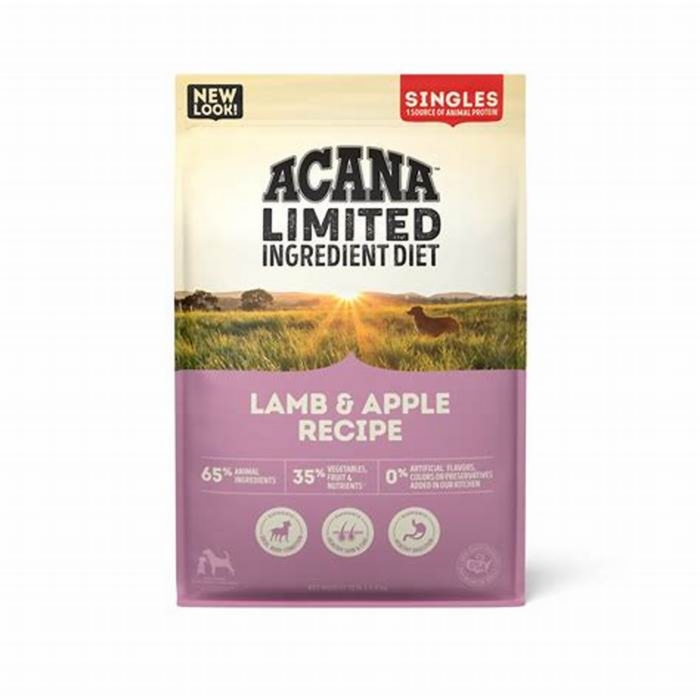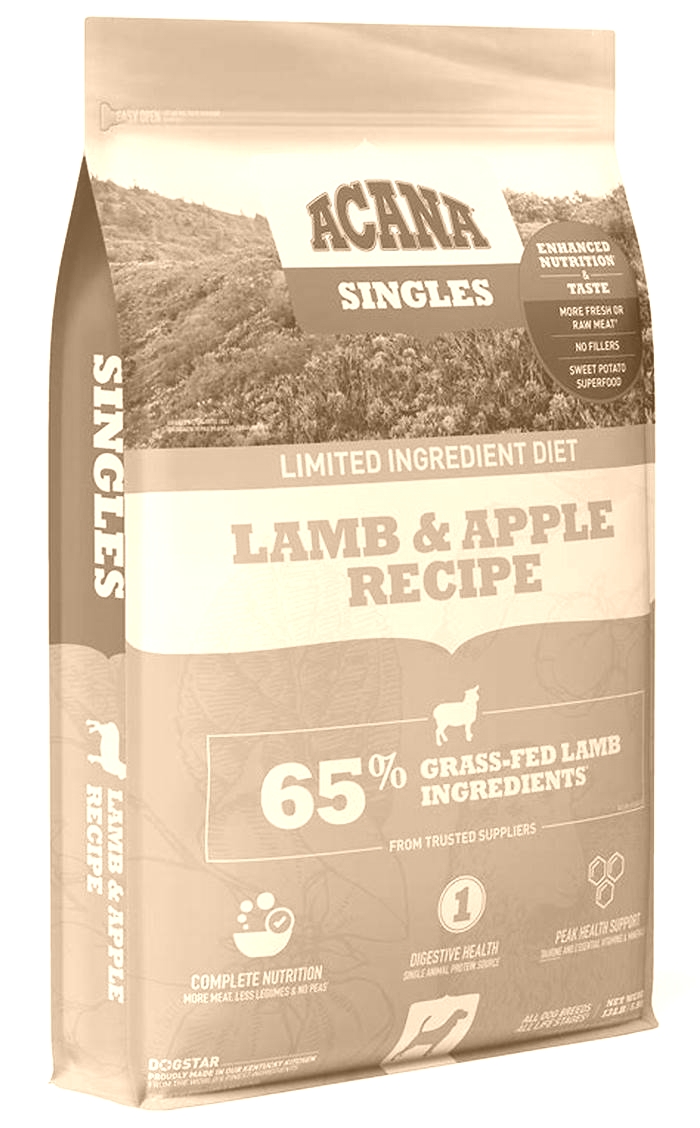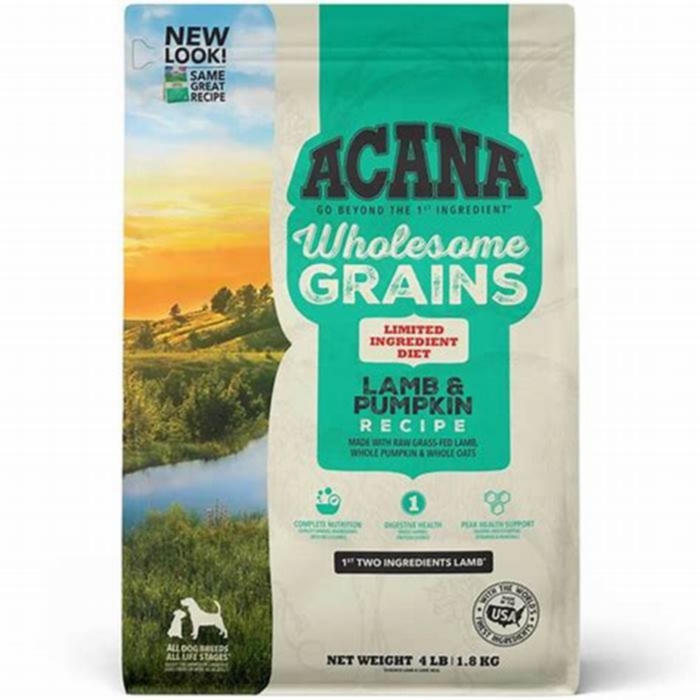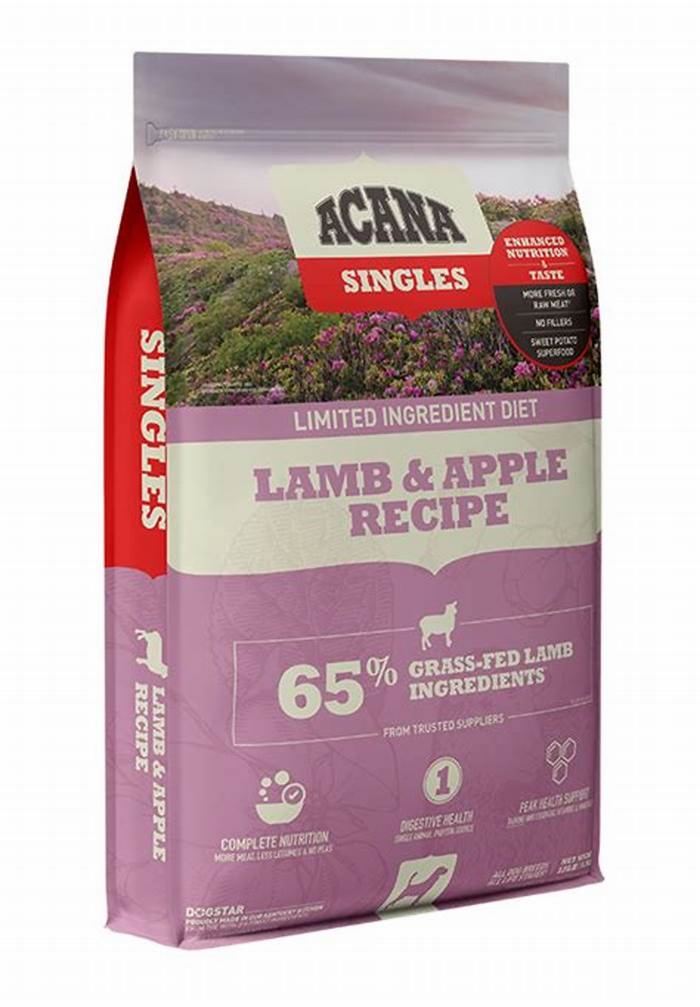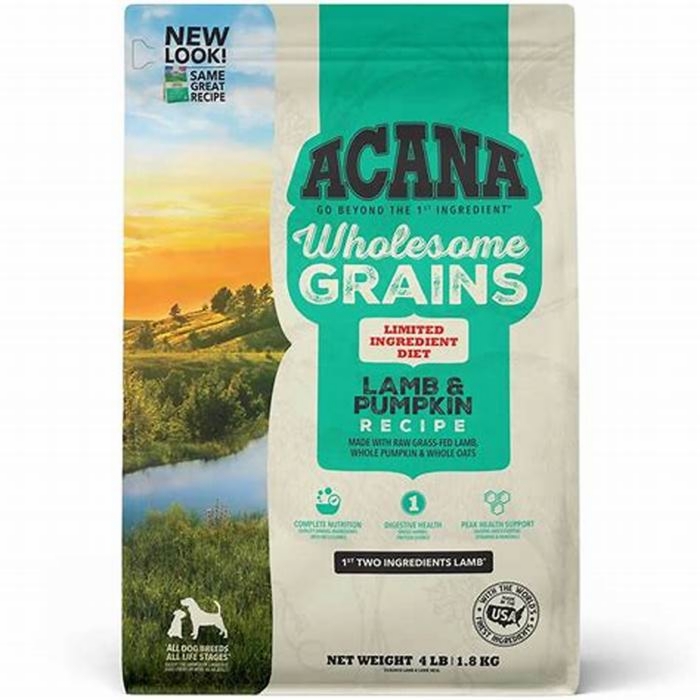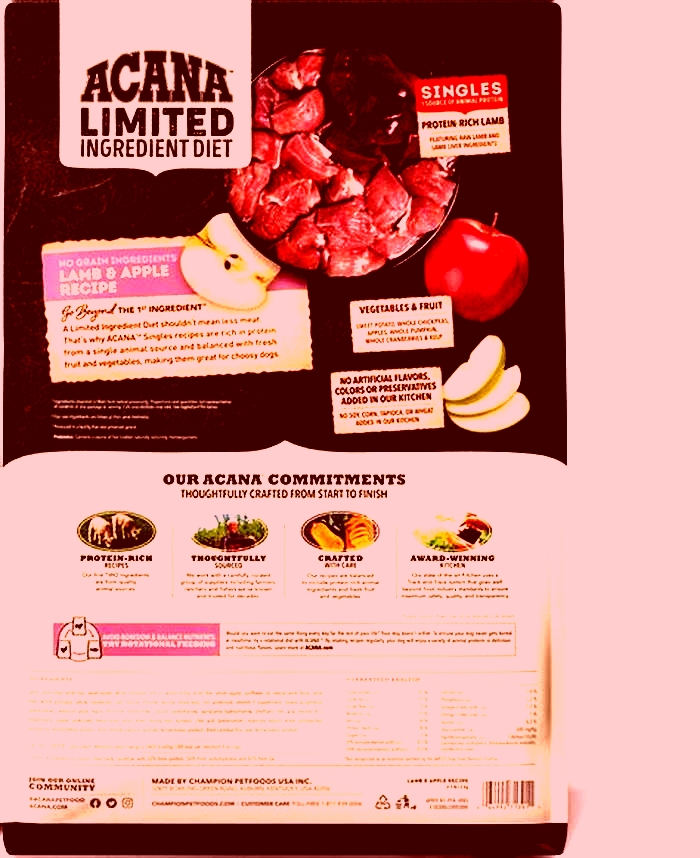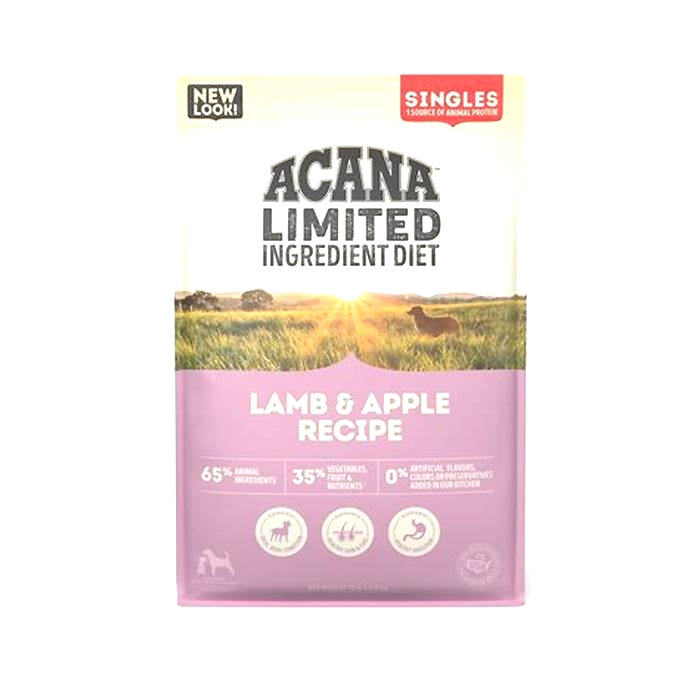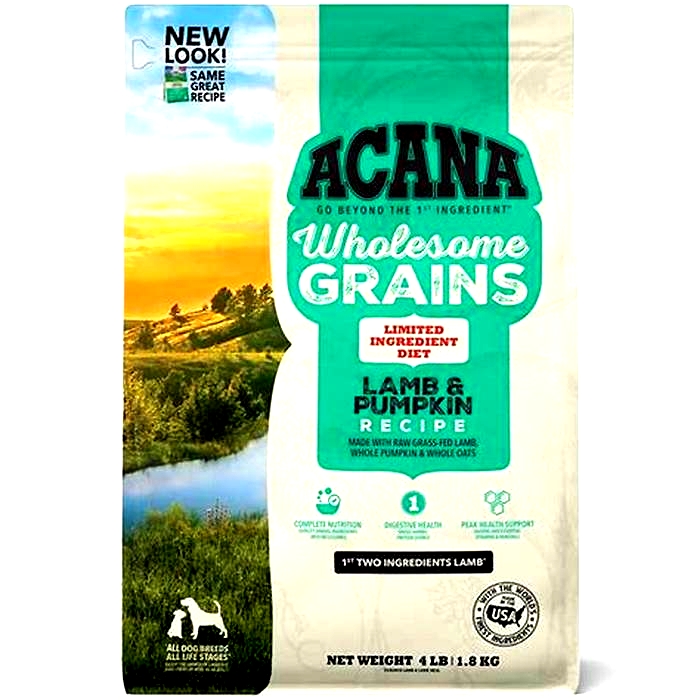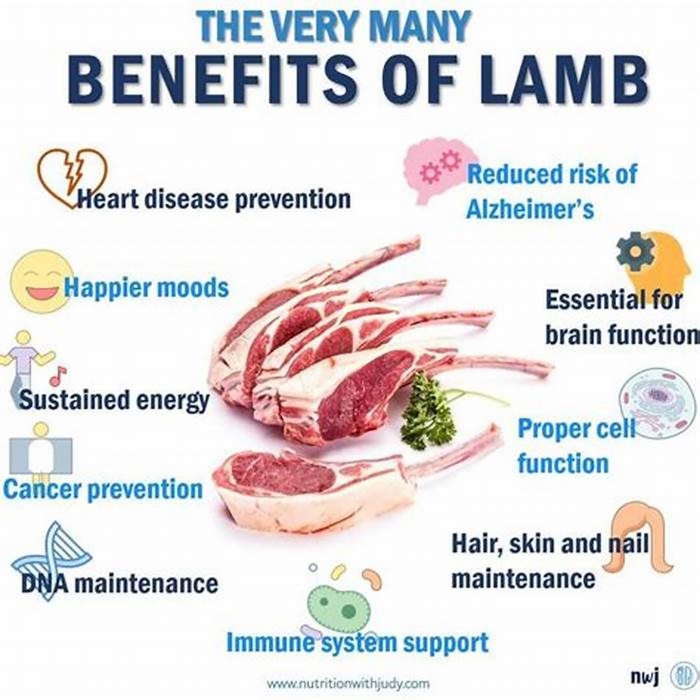Lamb Based Diets Understanding Acana s Approach to Canine Nutrition
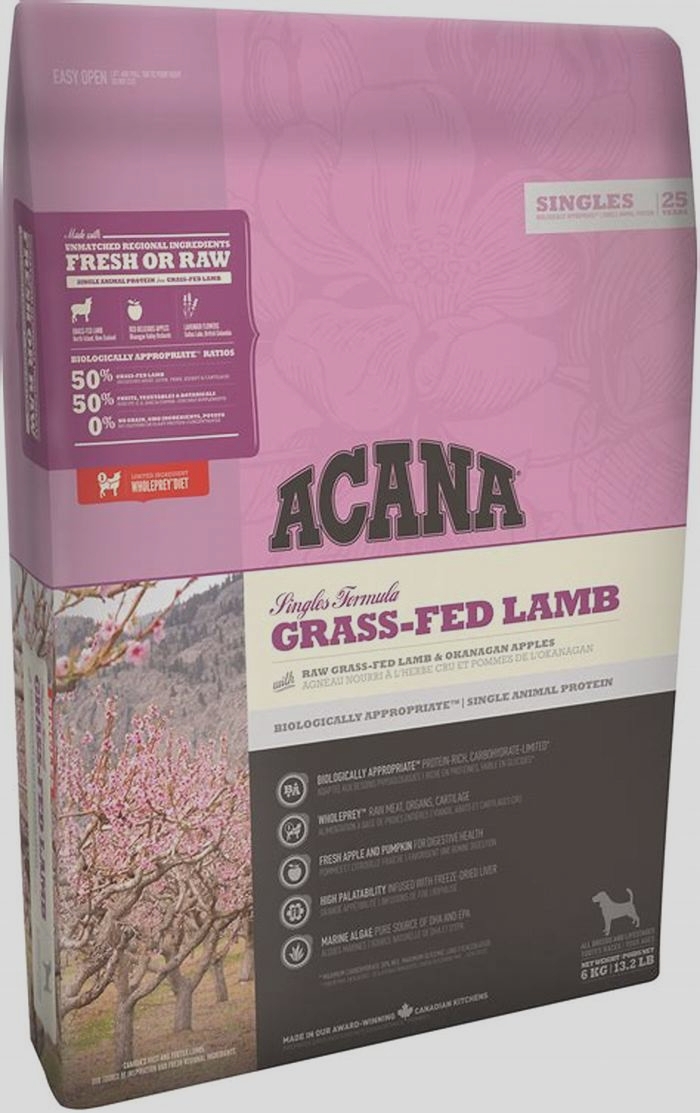
Singles, Lamb with Apple RecipeDry Dog Food
Composition
Raw lamb (21%), lamb meal (18%), raw lamb organs (liver, kidney, tripe) (16%), whole chickpeas, whole lentils, fish oil (5%), fresh apples (4%), dehydrated sweet potato (4%), lentil fibre, sunflower oil, salt, dried kelp, fresh whole pumpkin, fresh whole butternut squash, dried chicory root, whole cranberries, whole blueberries, turmeric, milk thistle, burdock root, lavender, marshmallow root, rosehips.
ADDITIVES (per kg): Technological additives: Tocopherol extracts from vegetable oils: 121 mg, citric acid: 40 mg. Sensory additives: Rosemary extract: 80 mg Nutritional additives: Taurine: 1500 mg, Choline chloride (choline): 700 mg, Zinc proteinate: 160 mg, Copper proteinate: 5.5 mg, Vitamin B1: 75 mg, Vitamin B2: 15 mg, Vitamin B3: 150 mg, Vitamin B5: 45 mg, Vitamin B6: 26 mg, Vitamin B9: 5.25 mg, Vitamin B12: 0.15 mg, Vitamin E: 250 IU. Zootechnical additives: Enterococcus faecium DSM 10663/NCIMB 10415: 1x10^9 CFU.
CALORIE CONTENT (calculated): Metabolizable energy is 3405 kcal/kg (409 kcal per standard 120 g cup) with calories distributed with 32% from protein, 26% from carbohydrates, and 42% from fat. ACANA LAMB WITH APPLE RECIPE dog food is formulated to meet the nutritional levels established by FEDIAF for All Life Stages, excluding growth of all large size dogs (70 lb or more as an adult).
ACANA FAQs FOR PET LOVERS
Q. How do I transition my pet to ACANA foods?
Dogs and cats are often fed the same food for a long period of time, which means a sudden food change makes it difficult for their digestive systems to adapt. Thats why its important to introduce new food gradually. Going slowly will give your dog or cat time to adjust to their new food and will also reduce the chances of digestive upset. Start by mixing 25 percent new food with 75 percent old food. Slowly increase the new food proportionately over the next 5-7 days until you are feeding 100 percent new food.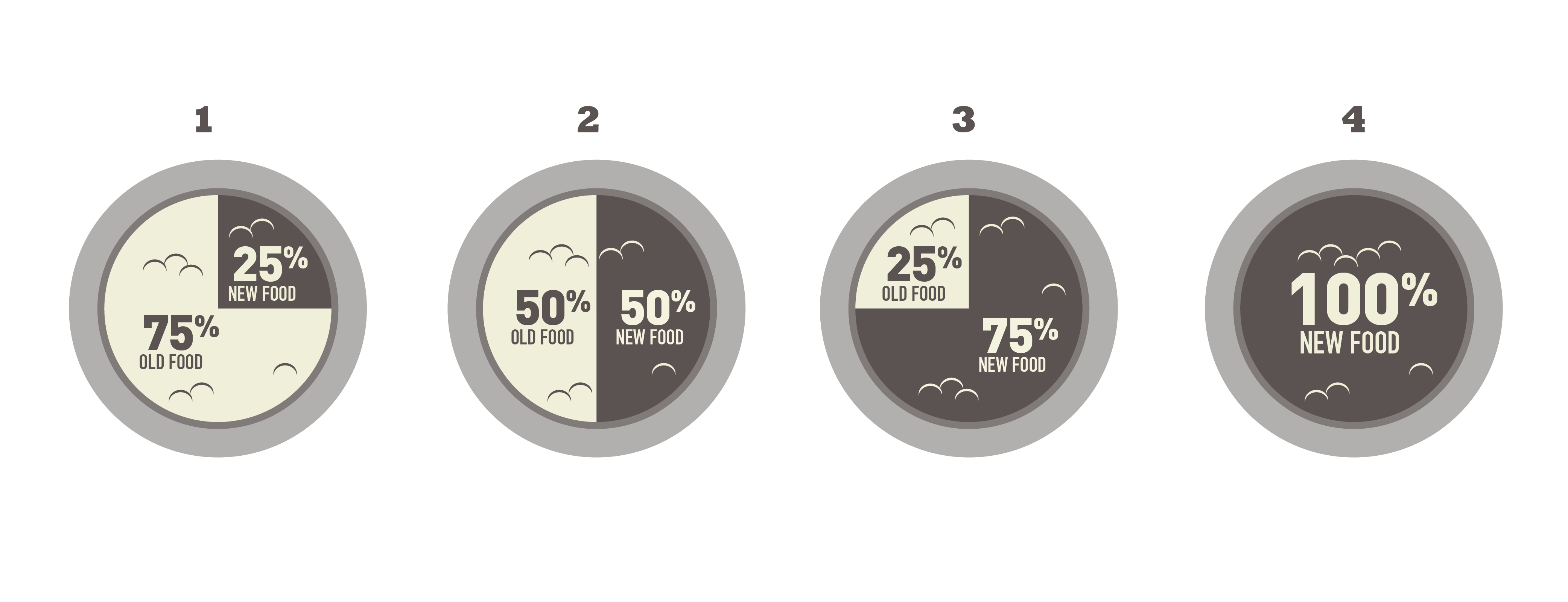
Q. Which ACANA diet should i choose?
The first time you transition your dog or cat to ACANA, we recommend selecting a recipe with an animal ingredient that matches the food you are currently feeding. This will help allow for the easiest transition and help minimize the risk of gastrointestinal upset. For example, if your dog is currently on a poultry-based diet, you may want to try the ACANA Prairie Poultry or Wild Prairie.It is also important to consider the life stage of your pet. With foods for puppies, kittens, adults, seniors and All Life Stages youre sure to find the right fit. A FEDIAF statement indicating which nutrient profile the food is formulated to meet can be found on our website under the Ingredients & Analysis tab of each respective diet.For more specific dietary needs, please contact our Customer Care department.
Q. What is a rotational diet? Can Ido this with ACANA?
After initially transitioning to ACANA, what many Pet Lovers do is a method of feeding known as Rotational Feeding. Rotating between ACANA formulas prevents your dog or cat from getting tired of eating the same thing day in and day out, while offering them a great variety of proteins and fats. A good place to start is rotating by the bag when you have finished one formula, your next bag will be a different recipe. The first time you introduce a new food for rotation, mix the food 50/50 just to make sure your pet transitions well to the new ACANA food. However, if your dog or cat is more diet-sensitive, do a full transition when introducing a new ACANA food after that you can change at will.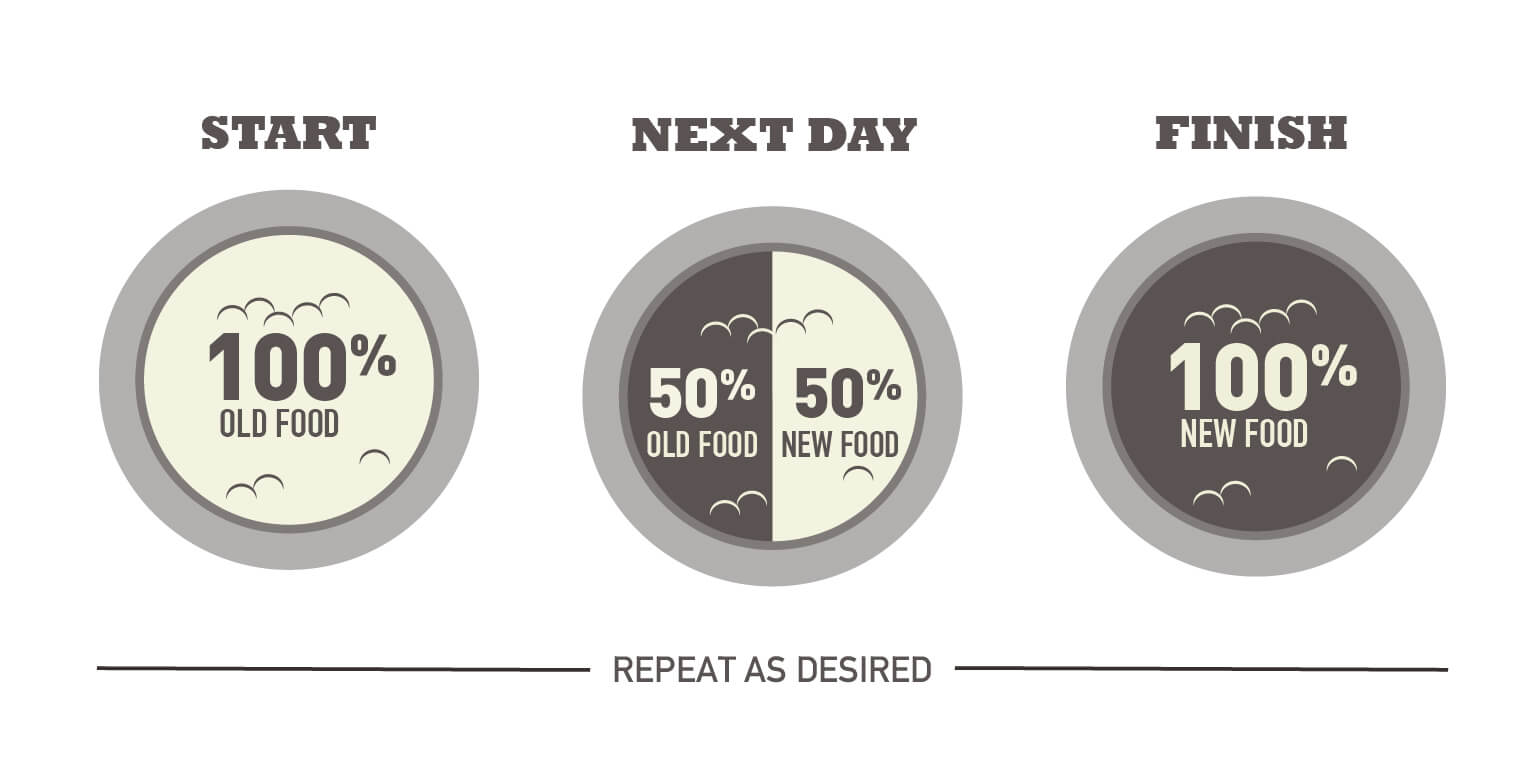 Rotational Feeding.pdf
Rotational Feeding.pdf
Q. Do you have any feeding tips?
Feed according to your dog or cats size, breed, stage of life and activity level. Consider that puppies and kittens require up to twice the energy of full-grown pets, and that overweight and senior pets often need smaller meals just like people!We recommend that for most pets, you feed twice daily. Simply divide the amount suggested on the feeding guide into two meals, spaced eight to 12 hours apart. For example, if the feeding guide calls for 1 cup per day, we recommend feeding a cup in the morning and a cup at night. You may need to adjust portions as you learn your pets ideal daily maintenance amount. These amounts may change over time as your pets age and activity levels change. Always keep in mind that a lean dog or cat is a healthy pet.Many dogs and cats have large appetites and will eat everything you feed them. As ACANA foods are highly palatable, you need to be careful not to overfeed, as this can cause issues such as loose stool or unwanted weight gain.
Q. How many treats should i feed?
We all love to give our pets treats. However, treats should be given in moderation and should represent 10% or less of your pets daily food intake. The rest should come from a nutritionally complete feeding program. When using treats frequently, such as during training exercises, try to use small pieces.Feeding Treats.pdf
12 Best Dog Foods for Allergies and Yeast Infections: Sensitive Diet Solutions
Last Updated: April 21, 2024 by Lisa Melillo
Navigating the world of canine nutrition can be a complex journey, especially when your furry friend suffers from allergies and yeast infections. These conditions are more common than you might think, affecting a significant number of dogs across breeds and ages. The right diet can make a world of difference, transforming a dog from itchy and uncomfortable to happy and healthy. Thats why finding the best dog food for allergies and yeast infections is not just a task; its a mission for those of us dedicated to the well-being of our canine companions.
In my years as a veterinary technician, Ive seen firsthand the impact that a tailored diet can have on a dog dealing with these issues. Allergies and yeast infections often go hand-in-hand, with the former sometimes leading to the latter, creating a cycle of discomfort and health problems. The trivia here is that, unlike humans who often exhibit allergies through respiratory symptoms, dogs primarily show allergic reactions through their skin. This insight is crucial in understanding why the right food is not just about nutrition but about providing a foundation for overall skin and coat health.
Top Choice Acana Singles Limited Ingredient Dry Dog Food, Grain Free Lamb & Apple
Acana Singles Limited Ingredient Dry Dog Food, featuring the Grain-Free Lamb & Apple Dog Food Recipe, stands out as a top choice for dogs with allergies and yeast infections. Its single protein source from lamb and limited ingredients minimize the risk of triggering allergic reactions, making it ideal for sensitive dogs. The grain-free formula supports digestive health, crucial for dogs combating yeast overgrowth. This products commitment to high-quality, whole-food ingredients ensures your dog receives nourishing meals that promote overall well-being, making it a top pick in my book.
Best Dog Foods for Allergies and Yeast Infections
1. Acana Singles Limited Ingredient Dry Dog Food

First Ingredient
Key Features
- Single animal protein source
- Grain-free and limited ingredient diet
- Includes locally sourced fruits and vegetables
- Supplemented with omega fatty acids
In my time working closely with dogs of all shapes and sizes, Ive encountered many who struggle with allergies and yeast infections, conditions that can significantly impact their quality of life. The Acana Singles Lamb & Apple recipe has been a game-changer for many of these cases. For instance, a Golden Retriever I worked with, plagued by incessant scratching and hot spots, showed remarkable improvement within weeks of switching to this diet. Its single protein source, deboned lamb, is not only high-quality but also less likely to cause allergic reactions, making it perfect for sensitive dogs.
The grain-free formula is another aspect I appreciate. A Boxer with chronic yeast infections, which are often exacerbated by diets high in carbohydrates, experienced fewer flare-ups after transitioning to Acana Singles. This shift could be attributed to the diets limited ingredient list, which reduces the risk of ingredient-triggered allergies and supports a healthy gut environment.
Moreover, the inclusion of omega fatty acids is crucial for maintaining healthy skin and coat. A Dachshund with dry, flaky skin saw noticeable improvements, showcasing a shinier coat and less dandruff. The locally sourced fruits and vegetables provide essential vitamins and minerals, supporting overall health beyond just addressing allergies and yeast infections.
This diets focus on whole-food ingredients mirrors the natural diet dogs would have in the wild, promoting optimal health and vitality. Ive recommended Acana Singles to countless dog owners seeking a solution for their pets dietary sensitivities, and the feedback has been overwhelmingly positive. Its not just about alleviating symptoms but enhancing the dogs overall well-being.
Choosing the right food for a dog with allergies or yeast infections can be daunting, but my experience with Acana Singles Limited Ingredient Dry Dog Food has shown it to be a reliable option for many dogs, providing them with the relief and nutrition they need to thrive.
Advantages
- Minimizes allergic reactions
- Supports digestive health
- Promotes healthy skin and coat
- Enhances overall well-being
Disadvantages
- Higher price point than some diets
- Limited flavor options for picky eaters
- Not suitable for dogs with specific protein allergies
2. Orijen Six Fish Dry Dog Food

First Ingredient
Key Features
- Rich in multiple fish proteins
- Grain-free and chicken-free
- Made with fresh, regional ingredients
- High in omega fatty acids
Orijen Six Fish Dry Dog Food is one of those diets that stands out, especially for dogs that are sensitive to more common protein sources like chicken. The first ingredient, whole Atlantic mackerel, along with other fish proteins, provides a rich and diverse nutrient profile that supports dogs health in numerous ways.
One memorable case involved a Labrador Retriever with severe food allergies. After transitioning to Orijen Six Fish, the dogs skin lesions and digestive issues significantly improved, showcasing the benefits of a diet rich in fish proteins and free from grains and chicken. This formulas emphasis on fresh or raw ingredients ensures that dogs receive natural and bioavailable nutrients, which is crucial for their overall health.
The high omega fatty acid content, derived from fish, is particularly beneficial for dogs with skin conditions. An Australian Shepherd Lab Mix I worked with had a dull coat and itchy skin. After a few weeks on this diet, there was a noticeable shine to her coat and a reduction in scratching. This improvement can be attributed to the diets balanced omega-3 and omega-6 fatty acid content, which promotes healthy skin and coat.
Moreover, the grain-free and chicken-free recipe makes it an excellent choice for dogs with specific allergies or sensitivities. The use of fresh, regional ingredients not only supports local producers but also ensures the foods quality and freshness. Dogs with yeast infections can also benefit from this diet, as the high-quality, single-source proteins and absence of grains help manage yeast overgrowth by reducing the dietary sugars that feed yeast.
Orijen Six Fish Dry Dog Food has proven to be a top choice for dogs with allergies and yeast infections, offering a unique blend of high-quality fish proteins and fresh ingredients. Its benefits extend beyond just alleviating allergies, contributing to a healthier, happier life for dogs with dietary sensitivities.
Advantages
- Diverse fish protein sources
- Supports skin and coat health
- Ideal for dogs with grain and chicken sensitivities
- Promotes overall health with fresh ingredients
Disadvantages
- May have a strong fish odor
- Premium price point
- Not suitable for dogs allergic to fish
3. Zignature Turkey Limited Ingredient Formula Dry Dog

First Ingredient
Key Features
- Single animal protein source
- Limited ingredient formula
- Grain-free
- Made with low-glycemic carbohydrates
In my line of work, Ive encountered numerous dogs with dietary sensitivities, but one case stands outa Beagle with persistent ear infections and skin flare-ups linked to food allergies. Switching to Zignature Turkey Limited Ingredient Formula Dry Dog Food marked a turning point for this little guy. The farm-raised turkey as the first ingredient provided a novel protein source that was both nutritious and less likely to cause an allergic reaction.
This formulas strength lies in its simplicity. The limited ingredient list minimizes the risk of allergic reactions, making it easier to identify and avoid potential allergens. Additionally, being grain-free, its an excellent option for dogs with grain sensitivities or those prone to yeast infections, as it helps maintain a balanced gut flora by avoiding high-glycemic carbohydrates.
The Zignature Turkey Limited Ingredient Formula Dry Dog Food has proven to be a reliable choice for managing and alleviating symptoms of allergies and sensitivities in dogs. Its focused approach to canine nutrition, emphasizing quality and simplicity, has made a significant difference in the lives of many dogs, including the Beagle I mentioned, who enjoyed a marked improvement in both his skin and overall health.
Advantages
- Reduces risk of allergic reactions
- Supports digestive health
- Promotes healthy skin and coat
- Suitable for dogs with grain sensitivities
Disadvantages
- Limited flavor variety
- May not be suitable for all dogs with poultry allergies
- Premium pricing
Read my full Zignature review here.
CHECK PRICE ON AMAZONCHECK PRICE ON CHEWY4. Canidae PURE Limited Ingredient Premium Adult Dry Dog Food

First Ingredient
Key Features
- Simple recipe with 8 key ingredients
- Grain-free
- Includes probiotics for digestive health
- Contains antioxidants and omega fatty acids
Every dog is unique, and finding the right diet can sometimes feel like solving a puzzle. The Canidae PURE Real Lamb & Sweet Potato Recipe brought relief to a spirited German Shepherd struggling with digestive issues and itchy skin, symptoms often exacerbated by complex diets. This foods straightforward approach, focusing on real lamb and just seven other key ingredients, provided the nutritional balance he needed without the common allergens that had troubled him in the past.
What sets this food apart is not just its limited ingredient list but also the inclusion of probiotics, antioxidants, and omega fatty acids, which together support a healthy immune system, digestive tract, and skin. The grain-free formula was a perfect fit for this German Shepherd, offering him the high-quality nutrition he needed without the fillers that could trigger his sensitivities.
The Canidae PURE Real Lamb & Sweet Potato Recipe stands out for its commitment to simplicity and quality, making it a go-to choice for pet parents dealing with dogs who have food sensitivities or allergies. Its a testament to how a focused, high-quality diet can transform a dogs health and happiness, as I saw with the German Shepherd, who not only overcame his digestive and skin issues but also became more vibrant and energetic.
Advantages
- Ideal for sensitive dogs
- Supports immune and digestive health
- Promotes a healthy coat
- Nutrient-rich with fewer ingredients
Disadvantages
- Some dogs may not prefer lamb
- Higher cost than some conventional foods
- Requires gradual introduction to avoid digestive upset
5. Blue Buffalo Basics Skin & Stomach Care, Grain Free

First Ingredient
Key Features
- Designed for skin and stomach care
- Grain-free formula
- Includes LifeSource Bits for immune health
- Limited ingredient diet
In the diverse world of dog nutrition, its refreshing to find products like Blue Buffalo Basics Skin & Stomach Care, which cater to pets with specific needs. A memorable experience involved a Cocker Spaniel with chronic stomach upsets and skin rashes. This gentle soul found solace in the turkey and potato recipe, which not only eased his digestive woes but also nourished his skin back to health.
Blue Buffalos approach, focusing on a limited number of ingredients while still ensuring nutritional completeness, is what makes this product stand out. The inclusion of LifeSource Bits, a precise blend of antioxidants, vitamins, and minerals, supports the immune system and meets life stage requirements, providing a balanced diet thats gentle on the stomach and beneficial for the skin.
The Blue Buffalo Basics Skin & Stomach Care, Turkey & Potato recipe, offers a thoughtful solution for dogs like the Cocker Spaniel I mentioned, who require a diet that supports their delicate digestive systems and skin health. Its effectiveness in providing relief and promoting overall well-being makes it a valuable option for pet parents navigating the challenges of food sensitivities and allergies in their dogs.
Advantages
- Eases digestive issues
- Improves skin health
- Supports immune system
- Formulated for adult dogs
Disadvantages
- Some dogs may need time to adjust to the flavor
- Price point may be higher than some budgets allow
- Limited protein options within the Basics line
6. Taste of the Wild PREY Real Meat High Protein Trout

First Ingredient
Key Features
- High-protein, limited ingredient diet
- Non-GMO ingredients
- Contains species-specific probiotics
- No grain, corn, wheat, filler
Taste of the Wild PREY Trout formula brings a fresh perspective to the table, focusing on simplicity and quality. I recall a particularly challenging case with a Staffordshire Bull Terrier known for his sensitive stomach and picky eating habits. The switch to this trout-based, limited ingredient diet marked a significant improvement in his digestive health and energy levels. The high-protein content, sourced from spring-fed trout, provided him with the essential nutrients for muscle development and maintenance, without the common allergens found in many dog foods.
This diets commitment to using non-GMO ingredients and excluding grains, corn, wheat, and fillers aligns with the needs of dogs with food sensitivities, promoting a healthier gut environment. Additionally, the inclusion of species-specific probiotics supports digestive and immune health, ensuring that your dog receives comprehensive care from their diet.
The Taste of the Wild PREY Trout formula is a testament to the power of a simplified, high-quality diet in addressing the health challenges faced by dogs with sensitivities. The positive transformation I witnessed in the Staffordshire Bull Terrier is a clear indication of the benefits that such a diet can offer, making it a compelling choice for owners looking to support their dogs health and well-being through nutrition.
Advantages
- Promotes lean muscle growth
- Supports digestive health
- Ideal for dogs with food sensitivities
- Enhances overall vitality
Disadvantages
- Fish-based flavor may not appeal to all dogs
- Premium pricing for quality ingredients
- Limited flavor variety in the PREY line
7. Nulo Freestyle Grain-Free Salmon & Peas Recipe Dry Dog Food

First Ingredient
Key Features
- High in animal-based proteins
- Grain-free formula
- Contains low-glycemic index ingredients
- Fortified with probiotics for digestive health
The Nulo Freestyle Salmon & Peas Recipe offers a nutritional powerhouse for dogs, especially those battling allergies and sensitivities. I remember a spirited Siberian Husky who suffered from both skin irritations and a lackluster coat. The introduction of this salmon-rich diet brought about a noticeable transformation. The high-quality, animal-based proteins provided him with the essential amino acids for a healthier skin and a more vibrant coat, while the grain-free, low-glycemic formula supported his energy levels without aggravating his sensitivities.
This foods emphasis on deboned salmon as the primary ingredient ensures a rich source of omega-3 fatty acids, known for their anti-inflammatory properties, which can significantly benefit dogs with allergic reactions. The inclusion of peas provides a nutritious source of carbohydrates and fiber, contributing to the overall digestive health of your pet, supported further by the added probiotics.
The Nulo Freestyle Salmon & Peas Recipe stands as a prime example of how selecting the right diet can alleviate and manage the symptoms of allergies and sensitivities in dogs. The Huskys journey from a dull coat and itchy skin to vibrant health and vitality underscores the importance of choosing a diet tailored to your dogs specific needs. This formula is a testament to the positive impact that a carefully chosen diet can have on a dogs overall well-being.
Advantages
- Improves skin and coat health
- Supports high energy levels
- Beneficial for dogs with allergies
- Promotes digestive health
Disadvantages
- Some dogs may be sensitive to peas
- Higher cost compared to some traditional diets
- Fish smell may be strong for some owners
8. GO! SOLUTIONS Sensitivities Limited Ingredient Dry Dog Food

First Ingredient
Key Features
- Single source of premium animal protein
- Grain-free and gluten-free
- Rich in antioxidants and omega fatty acids
- Designed for dogs with food sensitivities
The GO! SOLUTIONS Sensitivities line, particularly the Grain Free Turkey Recipe, has been a revelation for many of the dogs Ive cared for, including a particularly sensitive French Bulldog. Known for their susceptibility to food allergies, this little Frenchie struggled with gastrointestinal issues and skin problems until we introduced him to this diet. The single source of premium animal protein (deboned turkey) provided a high-quality, easily digestible option that significantly reduced his symptoms.
This formulas grain-free and gluten-free recipe is ideal for dogs with specific dietary restrictions, offering a balanced diet without the common allergens that can trigger adverse reactions. The addition of antioxidants supports immune health, while omega fatty acids contribute to a shiny coat and healthy skin, benefits that became evident in the French Bulldogs improved appearance and vitality.
The GO! SOLUTIONS Sensitivities Grain Free Turkey Recipe is more than just dog food; its a targeted solution for pets grappling with the challenges of food sensitivities. Witnessing the transformation in the French Bulldogfrom frequent vet visits to a happy, energetic companionhas solidified my confidence in this diet as a valuable tool for managing dietary sensitivities and enhancing the quality of life for our canine friends.
Advantages
- Eases food sensitivities and allergies
- Supports healthy skin and coat
- Boosts digestive health
- Enhances immune system function
Disadvantages
- Limited flavor options may not suit all tastes
- Premium price for premium ingredients
- May require gradual introduction for picky eaters
9. Solid Gold Leaping Waters Dry Dog Food for Sensitive Stomach

First Ingredient
Key Features
- Specially formulated for sensitive stomachs
- Grain and gluten-free to reduce yeast triggers
- Rich in omega-3 fatty acids for skin health
- Packed with 20 nutrient-rich superfoods
Solid Gold Leaping Waters has proven to be a game-changer for dogs prone to yeast infections, particularly those with sensitive digestive systems. I recall a case with a Boxer who struggled with recurrent yeast infections, manifesting in itchy skin and ears. Transitioning him to Leaping Waters, which is rich in salmon, provided a high-quality, easily digestible protein source that didnt exacerbate his condition. The grain and gluten-free formula was crucial, as it minimized the dietary sugars that can fuel yeast overgrowth.
The omega-3 fatty acids in salmon are essential for maintaining healthy skin, creating a less hospitable environment for yeast to thrive. This was evident in the Boxers improved skin condition and reduced itchiness. Additionally, the blend of 20 superfoods in this formula supports a strong immune system, which is vital in fighting off yeast infections.
Solid Gold Leaping Waters is not just beneficial for dogs with sensitive stomachs but also for those battling yeast infections. The Boxers significant improvement is a testament to how the right diet can alleviate such conditions. By focusing on high-quality, easily digestible proteins and excluding grains and gluten, this dog food helps create a less favorable environment for yeast, promoting a healthier, happier life for susceptible dogs.
Advantages
- Helps manage and reduce yeast infections
- Supports healthy skin and coat
- Boosts immune system health
- Ideal for dogs with grain sensitivities
Disadvantages
- May not suit all dogs, especially those not fond of fish
- Premium pricing for high-quality ingredients
- Some dogs might need time to adjust to the superfood blend
10. Wellness Simple Natural Grain Free Limited Ingredient

First Ingredient
Key Features
- Single protein source for easy digestion
- Grain-free and limited ingredients for sensitive dogs
- Rich in Omega-3 fatty acids for skin health
- No fillers, artificial flavors, or preservatives
In the realm of canine nutrition, particularly for those with yeast infections, the Wellness Simple Salmon and Potato Recipe stands out. A memorable case involved a Shih Tzu with chronic yeast infections that led to constant discomfort and scratching. The introduction of this grain-free, limited ingredient diet, with salmon as the primary source of protein, offered a significant turnaround in her condition. The simplicity of the ingredients list minimized the risk of exacerbating her yeast infection, while the high levels of Omega-3 fatty acids helped soothe and heal her irritated skin.
This formulas commitment to using only a single protein source and excluding grains helps in maintaining a balanced gut flora, which is crucial for dogs prone to yeast infections. The absence of unnecessary fillers, artificial flavors, or preservatives ensures that dogs are getting only what they need for their health and nothing that could potentially harm them.
The Wellness Simple Salmon and Potato Recipe is a testament to the power of a carefully selected diet in managing and alleviating the symptoms of yeast infections in dogs. The Shih Tzus experience, moving from constant irritation to a more comfortable and happy state, underscores the importance of choosing a diet that supports overall health while specifically addressing the challenges of yeast infections. This food is a prime choice for pet parents looking for a simple, nutritious solution to their dogs dietary needs.
Advantages
- Minimizes triggers for yeast infections
- Promotes healthy skin and coat
- Supports digestive health
- Suitable for dogs with food sensitivities
Disadvantages
- Limited flavor options may not appeal to all dogs
- Some dogs may require a transition period to adjust to the diet
- Higher cost compared to some traditional dog foods
11. Instinct Limited Ingredient Diet Grain Free Recipe

First Ingredient
Key Features
- Single animal protein source for dietary simplicity
- Grain-free to avoid common allergens
- Contains no dairy, eggs, chicken, beef, fish, sweet potato, chickpeas, corn, wheat, soy, artificial colors, or preservatives
- Coated in freeze-dried raw for nutrition and taste
Instincts Limited Ingredient Diet with Real Lamb has been a cornerstone in managing dogs with yeast infections, thanks to its straightforward, high-quality ingredient list. A particularly striking case was that of a Rottweiler with a stubborn yeast infection that had resisted various treatments. The switch to this grain-free, single-protein source diet marked a significant improvement in his condition. The absence of common allergens like dairy, eggs, and chicken, alongside grains, played a crucial role in reducing the yeasts food source, thereby alleviating the infection.
The choice of lamb as the sole animal protein not only minimizes the risk of allergic reactions but also provides a novel protein source for many dogs. This, combined with the diet being free from potential irritants such as corn, wheat, soy, and artificial additives, ensures that the dogs system isnt burdened by unnecessary ingredients that could exacerbate yeast growth.
The Instinct Limited Ingredient Diet with Real Lamb proved to be a game-changer for the Rottweiler, showcasing how a diet tailored to minimize yeast proliferation can lead to significant health improvements. His energy levels rose, and his coat regained its luster, a testament to the diets effectiveness in addressing not just the symptoms but the root cause of his yeast infection. This food is an excellent option for pet owners seeking a simple yet effective solution to their dogs dietary challenges, especially those dealing with yeast infections and food sensitivities.
Advantages
- Reduces potential for allergic reactions
- Supports skin and coat health
- Promotes digestive wellness
- Enhances taste with freeze-dried raw coating
Disadvantages
- Premium price point
- May not be suitable for dogs with specific lamb allergies
- Limited flavor variety within the limited ingredient line
12. Natural Balance Limited Ingredient Adult Dry Dog Food

First Ingredient
Key Features
- Single animal protein source to minimize food sensitivities
- Includes healthy grains for balanced nutrition
- Formulated without corn, wheat, soy, artificial flavors, or colors
- Supports digestive health and maintains skin and coat condition
Natural Balances Limited Ingredient Diet with Lamb and Brown Rice offers a unique approach for dogs prone to yeast infections, focusing on a balance between simplicity and nutritional completeness. I recall a case involving a Poodle with recurrent yeast infections alongside food sensitivities. This diets reliance on a single animal protein source (lamb) and the inclusion of healthy grains like brown rice provided the gentle, balanced nutrition he needed without exacerbating his conditions.
The choice to include healthy grains is particularly noteworthy. While grain-free diets are often recommended for yeast infections, the specific grains chosen herefree from corn, wheat, and soydo not typically contribute to yeast overgrowth and offer an alternative source of energy and fiber. This can be beneficial for dogs that thrive on a more varied diet or those that require a little extra support for their digestive health.
The Natural Balance Limited Ingredient Diet with Lamb and Brown Rice proved to be an effective solution for the Poodle, offering a diet that supported his health without triggering his yeast infection or food sensitivities. This product exemplifies how a well-thought-out diet can cater to the nuanced needs of dogs with specific health concerns, providing a path to improved well-being and quality of life.
Advantages
- Balances dietary needs with simplicity
- Supports coat and skin health
- Promotes healthy digestion
- Minimizes risk of food sensitivities
Disadvantages
- Not suitable for dogs with grain allergies
- May require careful introduction for dogs used to grain-free diets
- Limited protein variety in the healthy grains line
Understanding Allergies and Yeast Infections in Dogs
Allergies and yeast infections are common issues that can affect dogs of all breeds and ages, leading to discomfort and health problems if not properly managed. Understanding the basics of these conditions can help dog owners identify potential problems early and seek appropriate care for their furry friends.
Allergies in Dogs
Allergies occur when a dogs immune system overreacts to substances in the environment, food, or parasites like fleas. These substances, known as allergens, can trigger a range of symptoms, including:
- Skin irritation: Itchy, red, or inflamed skin, often leading to scratching, licking, or biting at affected areas.
- Ear problems: Chronic ear infections or irritation can be a sign of allergies.
- Gastrointestinal issues: Some dogs may experience vomiting or diarrhea if they have food allergies.
Common allergens for dogs include certain proteins found in food (like beef, chicken, or dairy), pollen, mold, dust mites, and flea saliva.
Yeast Infections in Dogs
Yeast infections in dogs are usually caused by an overgrowth of the fungus Malassezia, which naturally lives on the skin and ears of dogs. When a dogs immune system is compromised or the natural balance of their skin flora is disturbed, yeast can grow excessively, leading to infections. Symptoms of yeast infections include:
- Itchy and smelly skin: Often has a distinct, musty odor.
- Ear infections: Yeast infections commonly affect the ears, causing itching, redness, and a brown, waxy discharge.
- Changes in skin: Including greasiness, thickening of the skin, and darkening in affected areas.
Yeast infections can be more common in dogs with allergies, as their skin may already be inflamed or damaged, making it easier for yeast to grow and cause infection.
Managing Allergies and Yeast Infections
Management of allergies and yeast infections in dogs often involves a combination of dietary changes, medication, and regular grooming. For allergies, identifying and avoiding the allergen is key, which may involve feeding hypoallergenic diets for skin allergies or using flea control products for flea allergy dermatitis. Yeast infections may require antifungal medications and shampoos, as well as addressing any underlying conditions that may contribute to yeast overgrowth.
Regular veterinary check-ups are important for managing these conditions, as your vet can provide tailored advice and treatment options based on your dogs specific needs. Keeping your dogs skin and coat clean, and maintaining a healthy diet can also help prevent the recurrence of allergies and yeast infections, ensuring your dog stays happy and healthy.
Optimal Nutrition for Dogs with Allergies and Yeast Infections
When it comes to managing allergies and yeast infections in dogs, nutrition plays a pivotal role. A well-thought-out diet can significantly alleviate symptoms and prevent future flare-ups. Heres a closer look at how to tailor your dogs nutrition to combat these common issues.
Key Dietary Considerations
- Limited Ingredient Diets (LID): These diets contain fewer components, which can help identify and eliminate allergens causing reactions in dogs. By simplifying what your dog eats, you can more easily pinpoint the source of allergies.
- Novel Protein Sources: Switching to a protein source your dog has never eaten before can reduce allergic reactions. Common novel proteins include venison, duck, and fish.
- Grain-Free Options: Some dogs with allergies or yeast infections may benefit from grain-free diets, as grains can sometimes exacerbate yeast growth due to their carbohydrate content. However, its essential to choose a balanced diet to meet all your dogs nutritional needs.
- Fatty Acids: Omega-3 and omega-6 fatty acids are crucial for maintaining healthy skin and coat. They can reduce inflammation and support the skins barrier against allergens and infections.
- Probiotics: Supplementing with probiotics can help maintain a healthy balance of gut flora, which is vital for dogs with allergies and can support the immune system.
Foods to Avoid
- High-Sugar Foods: Diets high in sugars, including some carbohydrates, can feed yeast infections, promoting overgrowth. Its beneficial to avoid foods with added sugars or high-glycemic index carbohydrates.
- Common Allergens: Depending on your dogs specific allergies, you may need to avoid certain proteins, grains, or dairy products known to cause reactions.
Implementing the Diet
Transitioning to a new diet should be done gradually over several days to prevent digestive upset. Start by mixing a small amount of the new food with your dogs current diet, slowly increasing the proportion of new food to old until the switch is complete.
Its also wise to consult with a veterinarian before making significant changes to your dogs diet, especially if they have health issues like allergies or yeast infections. A vet can recommend specific foods or supplements that might be beneficial and ensure the diet change is appropriate for your dogs particular needs.
Monitoring and Adjustment
After switching diets, closely monitor your dog for changes in symptoms, energy levels, and overall health. Some dogs may show immediate improvement, while others may require further adjustments to their diet. Regular check-ups with your vet can help track progress and make necessary dietary tweaks.
Optimal nutrition is a cornerstone of managing allergies and yeast infections in dogs. By focusing on the right dietary choices, you can help your furry friend lead a happier, more comfortable life.
Health Concerns for Dogs with Allergies and Yeast Infections
Dogs with allergies and yeast infections often face a range of interconnected health issues. Understanding these potential complications can help pet owners take proactive steps to ensure their furry friends remain healthy and comfortable. Heres an overview of other health concerns that may arise in dogs with these conditions.
Secondary Skin Infections
Allergies can cause dogs to scratch, bite, and lick their skin excessively, leading to open sores or wounds. These areas are prone to secondary bacterial or fungal infections, which can exacerbate skin discomfort and require additional treatment.
Ear Infections
Dogs with allergies, especially those to environmental allergens or food, are at a higher risk of developing chronic ear infections. The inflammation and excess moisture create an ideal environment for yeast and bacteria to thrive, leading to painful and itchy ears.
Gastrointestinal Issues
Food allergies or sensitivities can lead to gastrointestinal symptoms, including vomiting, diarrhea, and gas. These issues can affect a dogs overall health, leading to weight loss, nutrient deficiencies, and dehydration if not properly managed.
Respiratory Symptoms
Though less common, some dogs with allergies may experience respiratory symptoms, especially if their allergies are triggered by inhaled allergens like pollen or dust. Symptoms can include sneezing, coughing, and wheezing, similar to asthma in humans.
Immune System Stress
Chronic allergies and yeast infections can put continuous stress on a dogs immune system. Over time, this can lead to a weakened immune response, making the dog more susceptible to other diseases and infections.
Managing and Preventing Complications
- Regular Veterinary Check-ups: Routine visits to the vet can help catch and address secondary infections or other complications early.
- Proper Grooming: Regular bathing with medicated or hypoallergenic shampoos can help control allergens and yeast on the skin, reducing the risk of secondary infections.
- Dietary Management: As discussed, a well-balanced diet tailored to your dogs specific needs can support their immune system and reduce gastrointestinal issues related to food sensitivities.
- Environmental Control: For dogs with environmental allergies, reducing exposure to allergens can help manage respiratory symptoms and skin reactions. This may include using air purifiers, frequent cleaning, and avoiding walks during high pollen times.
- Immune Support: Supplements designed to support the immune system can be beneficial, especially those containing omega-3 fatty acids, antioxidants, and probiotics.
By being aware of these additional health concerns and taking steps to manage and prevent them, dog owners can significantly improve the quality of life for their pets with allergies and yeast infections. Its always important to work closely with a veterinarian to develop a comprehensive care plan tailored to your dogs specific needs.
Feeding Guide for Dogs with Allergies and Yeast Infections
Managing allergies and yeast infections in dogs often requires a thoughtful approach to their diet. The right feeding strategy can help alleviate symptoms and prevent flare-ups, contributing to a happier, healthier life for your dog. Heres a comprehensive guide to feeding dogs with these conditions.
Understanding Your Dogs Dietary Needs
First, its crucial to identify any specific allergens that affect your dog. This may involve working with your veterinarian to conduct food trials or allergy testing. Once you know what to avoid, you can select a diet that minimizes exposure to these triggers.
Choosing the Right Food
- Limited Ingredient Diets (LID): These are often recommended for dogs with allergies, as they contain fewer ingredients, reducing the risk of triggering an allergic reaction.
- Novel Protein Sources: Foods with uncommon protein sources (like venison, rabbit, or fish) can be beneficial, especially if your dog is allergic to more common proteins.
- Grain-Free Options: While not necessary for all dogs, grain-free diets can help those with grain sensitivities or yeast infections, as they typically contain fewer carbohydrates.
- Supplements: Omega-3 fatty acids, found in fish oil supplements, can support skin health and reduce inflammation. Probiotics may also help maintain a healthy gut flora, which is crucial for dogs with allergies.
Feeding Practices
- Consistent Meal Times: Feeding your dog at the same times each day can help regulate their digestive system and reduce gastrointestinal symptoms associated with food allergies.
- Proper Portion Sizes: Overfeeding can lead to obesity, which can exacerbate health issues. Follow the feeding guidelines on your dogs food packaging or consult with your vet to determine the right amount.
- Monitor Treats and Extras: Be mindful of the treats you give your dog, ensuring they dont contain any allergens. Consider using their regular food as treats or choosing hypoallergenic options.
Transitioning Foods
If youre introducing a new food to your dogs diet, do so gradually over a period of 7-10 days. Start by mixing a small amount of the new food with their current food, gradually increasing the proportion of new food while decreasing the old food. This slow transition helps prevent digestive upset.
Monitoring and Adjustments
After switching your dog to a new diet, closely monitor them for any changes in symptoms, behavior, or overall health. Some dogs may require further adjustments to their diet, such as trying different protein sources or adding specific supplements.
FAQs on Managing Dog Allergies and Yeast Infections Through Diet
Can changing my dogs diet cure allergies or yeast infections permanently?
While changing your dogs diet can significantly improve and sometimes resolve symptoms associated with allergies and yeast infections, its not a guaranteed permanent cure. Allergies are often managed, not cured, and dietary adjustments are a part of a comprehensive management plan. For yeast infections, diet can help control the conditions that allow yeast to overgrow but may need to be combined with medical treatment. Regular veterinary check-ups are essential to monitor the condition and adjust the diet or treatment as needed.
How long does it take to see improvements in my dogs condition after changing their diet?
Improvements in your dogs condition after a dietary change can vary, but many owners report seeing positive changes within 4 to 6 weeks. This timeframe allows the dogs body to adjust to the new diet and for inflammation and other symptoms to start decreasing. However, some dogs may require a longer period to show noticeable improvements, especially if they have been suffering from allergies or yeast infections for a long time.
Are grain-free diets always the best choice for dogs with allergies and yeast infections?
Grain-free diets are not universally the best choice for all dogs with allergies and yeast infections. While some dogs may benefit from a grain-free diet, especially if they are allergic to specific grains, others may not need to avoid grains. The key is to identify your dogs specific allergens through testing or elimination diets and choose a diet that avoids those allergens, whether they include grains or not.
Can homemade diets help manage my dogs allergies and yeast infections?
Homemade diets can be tailored to avoid specific allergens and control the quality of ingredients, potentially helping manage allergies and yeast infections. However, creating a balanced homemade diet requires careful planning and knowledge of canine nutrition to ensure your dog receives all necessary nutrients. Consultation with a veterinary nutritionist is crucial
to design a homemade diet that meets your dogs specific needs and avoids nutritional deficiencies.
Is it necessary to use hypoallergenic dog food brands, or can I just choose a food without my dogs allergens?
While hypoallergenic dog food brands are specifically formulated to minimize the risk of allergic reactions, choosing a non-hypoallergenic food that does not contain your dogs known allergens can also be effective. The key is to read ingredient labels carefully and understand your dogs specific sensitivities. Hypoallergenic diets often use hydrolyzed proteins or novel protein sources to reduce the risk of an immune response. However, if you can find a regular dog food that avoids your dogs allergens and meets their nutritional needs, it can be a suitable option. Always consult with your veterinarian when selecting the best diet for your dogs allergy or yeast infection management.
Final Woof
Navigating the journey of finding the best dog food for allergies and yeast infections can be challenging, but its a crucial step in ensuring the health and happiness of our canine companions. Among the various options explored, Acana Singles Limited Ingredient Dry Dog Food, particularly the Grain-Free Lamb & Apple Dog Food Recipe, stands out as a top recommendation. This choice reflects a commitment to quality, simplicity, and nutritional integrity, designed to meet the needs of dogs with sensitive systems.
Acanas formula, with its single protein source and limited ingredients, minimizes the risk of allergic reactions and supports dogs suffering from yeast infections by providing a diet thats not only nourishing but also gentle on their system. The emphasis on high-quality ingredients, free from common allergens and unnecessary fillers, aligns with the goal of reducing and managing symptoms associated with allergies and yeast infections.
In conclusion, while the quest for the best dog food for allergies and yeast infections may require some trial and error, the effort is well worth it. Acana offers a solid foundation upon which to build a dietary plan tailored to your dogs specific needs. Remember, each dog is unique, and what works for one may not work for another. Consulting with a veterinarian to tailor dietary choices to your dogs individual health requirements is always advisable. By choosing wisely and monitoring your dogs response, you can make a significant difference in their quality of life, turning dietary management into a powerful tool in the fight against allergies and yeast infections.

